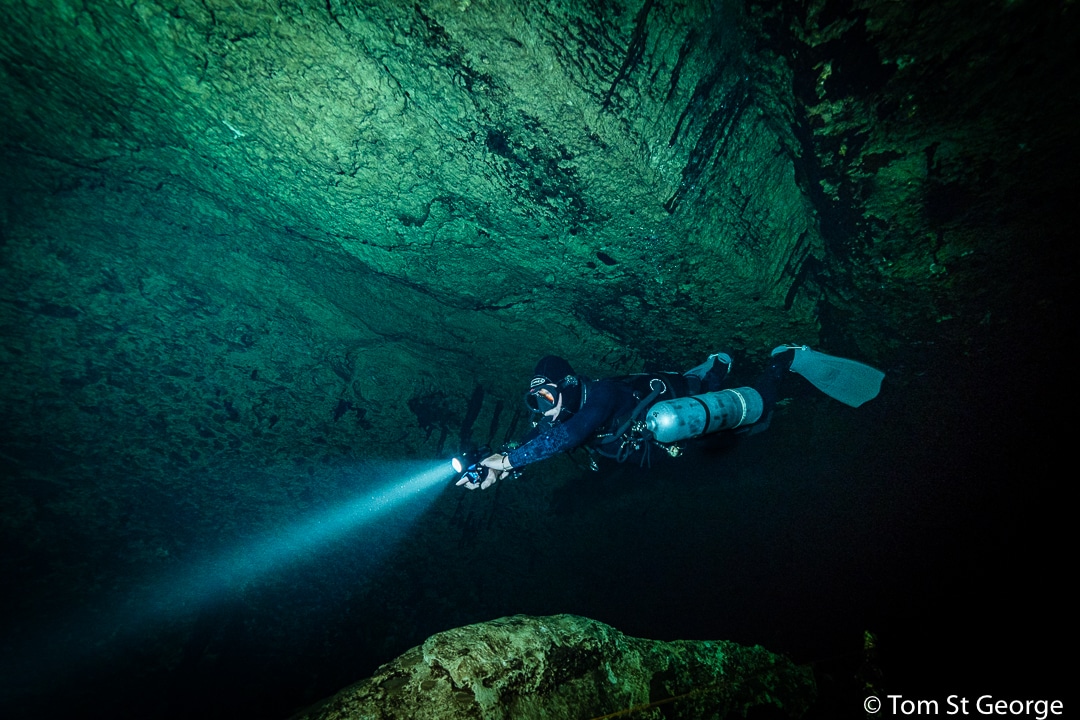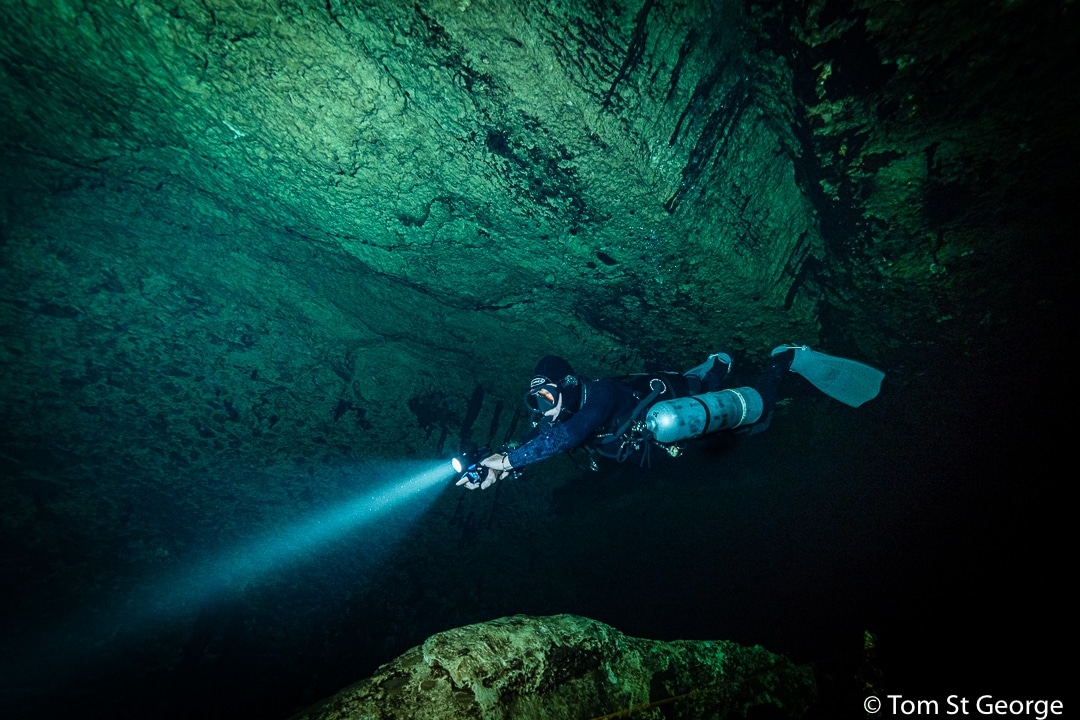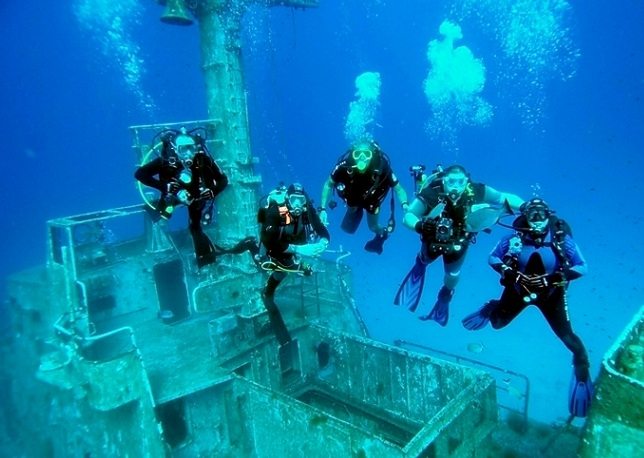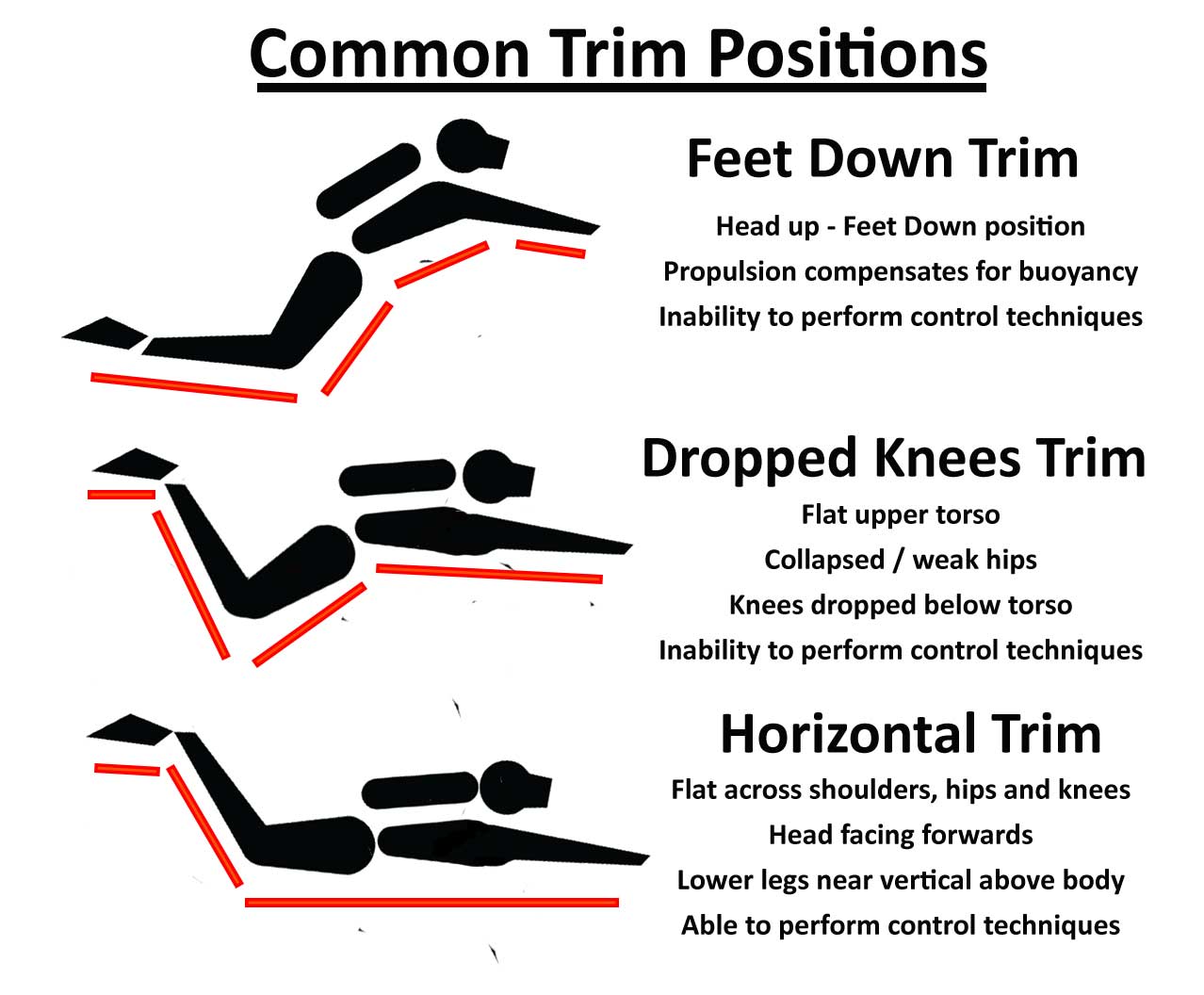News
Being Horizontal… ‘Cave Trim’ – the elusive goal

Watch a group of well-trained divers in the water — especially cave divers or technical divers — and you’ll notice they look a little different to most casual sport divers.
How different?
Well, the cave/technical/well-trained sport divers will be lying on the water (usually horizontal) rather than standing in it. Here’s what I mean:

A typical cave diver in trim… lying on the water
Photo: Tom St George
And here’s a picture of a group with a different in-water attitude:

A diver enjoying the water but working hard…
Photo: Dean McConnachie
So, let’s assume you’re not looking at those pictures and saying to yourself: “What’s the big deal?” Or “I can’t see any difference.”
Given that, let’s also assume you are interested in finding out why cave trim is preferred over the other. It’s not that anything other than horizontal is wrong. It’s just there’s something easier and better. (For the record, horizontal trim is not always exactly horizontal — occasionally the correct attitude in the water is head or feet down at varying angles for short periods — but it is the default.
Reason one to be horizontal: moving through the water is easier. You are streamlined and therefore water resistance moving ahead and backwards is at a minimum. Even with extra gear (more bottles, pockets full of tools and spanners, a pouch with backup mask, spare dive computer, lights, bits of string and a chicken sandwich), moving through the water in any direction is easier compared to swimming at it full-frontal. When a diver is streamlined, the thrust from each and every fin kick is translated into graceful movement. Progress from point A to point B and back again is more efficient, less work, uses less energy, uses less gas.
Reason two: when a diver’s flat in the water, she meets maximum water resistance going up or down. This helps her maintain position in the water column. Of course, this is a small effect compared to having buoyancy dialled in, but it’s nevertheless a factor.
One salient point when comparing cave trim to fins down orientation, is that being horizontal teaches good habits regarding buoyancy control. There is no temptation to kick to stay in place as there is with fins-down orientation. (For example, although the group picture above isn’t a video, I’d lay dollars to donuts that the two divers on the left and the one on the right are all working hard to maintain their position in the water column while the picture is being taken. They seem to have poor buoyancy control, and staying in place is an effort for them.
The cave diver pictured above is motionless, and literally hanging in the water waiting for the photographer — Tom St. George — to signal “okay. Got it!”)
Reason three: a diver in horizontal trim is much less likely to stir up silt and mud or damage whatever is below them. In fact, when using the correct propulsion technique (frog kick generally) and by keeping the knees bent and thighs parallel to her lateral line, a diver can be a hand’s breadth from the bottom and move without disturbing anything at all. This diagram may help illustrate the point.

When in horizontal trim, arch the back slightly by clenching your butt cheeks… think “Flamenco Dancer Skydiving.”
Illustration courtesy of Andy Davis, Scuba Tech Philippines
Okay, so how does one attain horizontal trim?
In a word: practice.
In more detail: commitment and practice!
Practice needs little explanation. Be patient, spend the time. A great approach is to dedicate a few dives to nothing but working on trim.
For an in-water exercise, get to a pool or shallow, calm waters, and dive with a buddy who has an underwater video camera to track your progress. Start by resting prone on a flat ledge or the pool bottom and gradually add a little lift to your buoyancy cell.
Critical to mastery is sticking to it (that’s the commitment), that and understanding the relationship between four things: gravity, buoyancy, you, your gear.
Essentially, you need to balance each of these things to come up with a perfect result. Luckily, two of them are constants and pull in exactly opposite directions. Gravity pulls you deeper, buoyancy pulls you towards the surface.
Simple… well, almost. What complicates matters are the other two things: you and the gear you are wearing.
Now let’s just say for brevity, you have reached the point where you have gravity and buoyancy perfectly balanced. Something called neutral buoyancy. You are not overweighted. You are not under-weighted. And in shallow water you are able to hover without moving your hands and feet.
At this point — hovering — you’re off to a great start. But now you need to get horizontal and stay there without moving your hands or feet (don’t scull, don’t swim, just hang in the water). Try it. If you’re lucky, it will work. Most likely though you’ll either tilt head down or feet down.
Let’s think about that situation for a minute.
As a for instance, say you need two kilos of ballast (lead weight) to achieve neutrality. These weights are over and above the ballast that’s a result of your scuba cylinders, lights, reels, and all the other crap we carry with us on a dive.
Now, divers usually carry lead ballast around their waist, so let’s says yours is about your mid-point. Now consider what would happen if we were to move that weight to the ends of your fins. Your feet would naturally swing down pulling you, your body, your kit, into a straight up and down orientation. Kind of similar to what happens when a “robust” child get on one end of a teeter-totter (a see-saw) and the “runt of the litter” is sitting on the opposite end.
Okay, so what would happen if you were silly enough to put the weights on your mask strap. Well, to begin with you’d orient head down and then your mask would most likely fall off. Goodbye mask. But if we think about the see-saw situation, same deal except now runt’s pet elephant is sitting on his lap and Robusto is up in the air.
You get the point. You are dealing with a lever. To achieve balance, either the weights on both ends have to be similar, or the distance from the balance point — the fulcrum — has to compensate for any difference. That’s to say, moving stuff that sinks in the water — weights in this instance, but also all the other bits and pieces of kit — is going to have a direct effect on in-water orientation.
Weights sink, so do scuba cylinders, lights, cameras, and a whole lot more including the gas we breathe (more than 2.5 kilos of “air” in a standard aluminium 11-litre tank for example). Understanding that moving each of these things away from your balance point has the potential to influence trim is key.
To achieve cave trim you want balance. Moving things around — even swapping light fins for heavier ones — can make that happen… or not.
But before that, you perhaps should consider things that have an effect on buoyancy: lungs, buoyancy cell (BCD, wing, etc.), drysuit, thick wetsuit. And each of these is a variable.
Also — and this is where things get interesting — things that are buoyant supply lift and the location of that lift can have an influence on trim as well. (Ask a new drysuit diver about their experience with floaty feet.)
You can experience something similar by moving a cylinder up and down in its retaining straps on a standard BCD.
All this serves to show us that the see-saw analogy used earlier may actually be an over simplification. It would be better to think of a fully kitted diver as a beam with a variable balance point rather than a simple lever with a fixed fulcrum.
Hang on. This has started to get a little over-the-top and way too complicated to explain without using Venn diagrams and video. No worries. Let’s stop now while we’re ahead because in truth, the take-away is essentially unchanged. You have the basics. Now let’s get in the water and practice.
Steve Lewis’s new book, Death in Number Two Shaft: the underwater exploration of Newfoundland’s Bell Island Mine, is available now on Steve’s website or from Amazon UK.
Find out more about Steve at www.techdivertraining.org.
Marine Life & Conservation
IUCN Spotlights Green Fins at Bali Ocean Days 2025, Calling for Stronger Business Model in Marine Conservation

IUCN (International Union for Conservation of Nature) Global Ocean Director, Minna Epps, has spotlighted Green Fins Indonesia along with a call for stronger business models that sustain marine conservation. Speaking at the inaugural session of Bali Ocean Days 2025 held on 7-8 February, Epps emphasised the need for sustainable financing to support and scale marine conservation initiatives such as Green Fins.

Activities earlier in the week with the Coral Triangle Center in Sanur and Ceningan Divers in the Nusa Penida Marine Protected Area shaped the IUCN Ocean Director’s message at the conference and showcase, aligning with the theme of the blue economy and impact finance to sustain marine ecosystems.

“Tourism has such a big impact on marine biodiversity, and we need it to adhere to a certain code of conduct,” Epps said. “That is why through our funding facilities, we worked with The Reef-World Foundation advancing Green Fins so dive operators can become certified with standards. But this kind of initiative has been around for a long time and it’s also a tool used to improve [MPA management], but it needs to come with a business model. I also believe in market-based instruments to evolve this programme.”

IUCN’s visit is part of their Blue Natural Capital Financing Facility (BNCFF), which supports at least 21 projects around the world, building the business case for investing in the future of our ocean.
In Indonesia, the project supported by IUCN was developed in partnership with The Reef-World Foundation, the Coordinating Body on the Seas of East Asia (COBSEA) and the Coral Triangle Center, which serves as the local implementing organisation for Green Fins. The initiative engages marine tourism businesses through voluntary sustainability certification based on the only internationally recognised environmental standards for diving and snorkelling operations. Green Fins’ activities aim to reduce negative environmental impacts associated with marine tourism activities as well as improve the management of marine protected areas.

IUCN’s promotion of Green Fins in Bali Ocean Days signals the need for greater private sector engagement in marine conservation across Indonesia and beyond.
Investors, donors, marine tourism operators and stakeholders looking to support scalable marine conservation solutions are encouraged to explore opportunities with The Reef-World Foundation, the international coordinator of the Green Fins initiative. To learn more about sustainable marine tourism and how to get involved, visit www.reef-world.org.

About Reef-World
The Reef-World Foundation is a registered UK charity which delivers practical solutions for marine conservation around the world. The charity promotes the wise use of natural resources – particularly coral reefs and related ecosystems – for the benefit of local communities, visitors and future generations. It is dedicated to supporting, inspiring and empowering governments, businesses, communities and individuals around the world to act in conserving and sustainably developing coastal resources.
Reef-World leads the global implementation of the UN Environment Programme’s Green Fins initiative, which focuses on driving environmentally friendly scuba diving and snorkelling practices across the industry globally. As such, the charity provides low-cost and practical solutions to local and industry-wide environmental challenges associated with the marine tourism industry. It provides education and capacity-building assistance to empower environmental champions (within the diving industry, local communities, authorities and governments) to implement proven coastal resource management approaches.
Visit www.reef-world.org to learn more or follow them on Facebook, Instagram and X.
About Green Fins
Green Fins is a proven conservation management approach – spearheaded by The Reef-World Foundation in partnership with the UN Environment Programme – which leads to a measurable reduction in the negative environmental impacts associated with the marine tourism industry. The initiative aims to protect and conserve coral reefs through environmentally friendly guidelines that promote a sustainable diving and snorkelling tourism industry. It provides the only internationally recognised environmental standards for the diving and snorkelling industry and has a robust assessment system to measure compliance.
Green Fins encourages and empowers members of the diving industry to act to reduce the pressures on coral reefs by offering dive and snorkel companies practical, low-cost alternatives to harmful practices – such as anchoring, fish feeding and chemical pollution – as well as providing strategic training, support and resources. By reducing the local direct and indirect pressures tourism puts on coral reefs, it helps make corals healthier and more resilient to other stresses such as the effects of climate change. Look for the Green Fins logo when booking your next dive trip.Visit www.greenfins.net to learn more or follow the initiative on Facebook, Instagram and X.
News
Filming 360 in The Bahamas

In December 2024, the Shark Trust had a very special opportunity to film sharks and rays in The Bahamas. Frogfish Photography are the Bahamas Dive Ambassadors for the UK. And Caroline, Deputy Editor at Scubaverse, is the Marketing Manager at the Shark Trust. So, when the need arose to film footage of several species of shark and ray for a new Shark Trust project, The Bahamas seemed the perfect fit. A huge thank you is needed here to the Bahamas Ministry of Tourism. As they stepped in to fully support the trip both financially and practically. Ensuring that the filming expedition ran smoothly, and that we got as much time as possible in the water with sharks and rays, during the 10 day, 3 island trip.

The Bahamas is famous for its sharks and rays. Divers flock there to experience getting up close to a range of species. Our itinerary saw us visit Nassau, Bimini and Grand Bahama. It packed in as many in-water experiences as possible and had us dive, snorkel, and even take a submarine to experience them in a variety of different habitats and to capture them on film. We saw 148 sharks and rays from 8 different species (all of which have been logged on the Shark Trust Shark Log!).

But why were we there? The expedition was designed to fulfil the needs of two new projects being launched by the Shark Trust in 2025. The filming done underwater on this trip was the start of creating OneOcean360: A Shark Story. A new 360 immersive experience designed primarily for immersive domes and planetariums. The film will be the nearest experience to getting in the water with sharks and rays without getting wet! It will bring the world of sharks to an audience that may never get the chance to experience it first-hand. A Shark Story aims to deepen people’s understanding of sharks, uncovering and illustrating why they are so wonderful as well as being vital to marine ecosystems.
The film is being made in collaboration with Real Immersive. Also based in Plymouth, they have an immersive dome and are providing the technical expertise behind creating this unique experience. Reviewing the footage in the dome has been an invaluable part of the process. Both inspiring the team and allow us to refine the filming techniques to suit this immersive theatre.

You might imagine that we are using expensive cameras and even more expensive housings. But this is not the case. The entire project is being filmed using Insta360 X4 cameras. With only a few simple additions to the standard dive setup. The INON weight plate allowed us to attach this camera to a dive weight, set it down on sand or wreck, and then swim away and let the sharks be the stars. And the results are very exciting. The film will be ready this autumn. It will be accompanied by an educational pack for teachers to take away after school trips to see the film. Encouraging all those that see it to continue learning about these incredible animals.
You can support the creation of OneOcean360: A Shark Story by heading to the crowdfunder page and donating or selecting a reward.
https://www.crowdfunder.co.uk/p/a-shark-story
Read about the shark and ray dives we did on Nassau, Bimini and Grand Bahama in our next blog post coming soon on Scubaverse.
-

 Gear Reviews1 month ago
Gear Reviews1 month agoGear Review: SurfEars 4
-

 News3 months ago
News3 months agoSanta Divers take the Plunge for Charity
-

 Marine Life & Conservation2 months ago
Marine Life & Conservation2 months agoPaul Watson Released as Denmark Blocks Japan’s Extradition Bid
-

 Blogs2 months ago
Blogs2 months agoJeff Goodman Launches Underwater Moviemaker Course with NovoScuba
-

 Blogs2 months ago
Blogs2 months agoExperience Malta and Gozo in 2025: A Paradise for Divers and Culture Lovers
-

 News2 months ago
News2 months agoDive into Adventure: Limited Space Available for January Socorro Liveaboard Trip with Oyster Diving
-

 Blogs3 months ago
Blogs3 months agoThe Benefits of Underwater Photography Workshops
-

 Blogs3 months ago
Blogs3 months agoDiscover Curaçao with the Ultimate Dive Vacation Guide – 2024 DEMA Special Edition















